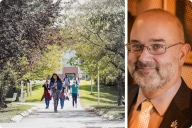You have /5 articles left.
Sign up for a free account or log in.
Some college buildings in Louisiana, Alabama and Mississippi were shuttered Monday as Hurricane Katrina came for a campus visit, while others became shelters for students from New Orleans who fled the 135 m.p.h. winds.
Colleges' central Web sites and phone lines were down -- "due to the hurricane … your call cannot be completed” -- at nearly every New Orleans college, but institutions are finding ways to reach their students. Tulane University set up an emergency Web site that says classes, which were supposed to start Wednesday, will start no sooner than September 7. Tulane also has a phone line where people can check on any of the 400 students who were evacuated to Jackson State University.
Midday, the wind and rain at Jackson State was not too severe, but “we’re expecting it to get severe,” said Anthony Dean, a university spokesman, who said about 400 Jackson State students, along with the Tulane students, were moved from dorms into the athletic center, the most stable building on campus. The Tulane football and soccer teams were kept together at Jackson State’s T.B. Ellis Gym. The football team practiced at the Louisiana Superdome over the weekend before evacuating. The team, which has a nationally televised game scheduled on Sunday, was kept together so it could resume practice promptly if the storm lets up.
The Green Wave gridiron stars weren’t the only ones thinking about getting a bit of work done with Katrina looking over their shoulders.
Dana Brown, professor of landscape architecture at Louisiana State University, fled her Baton Rouge home, which she said is “probably about 70 years old” and “wouldn’t stand up to this,” for the Design Building on campus, where she works. Brown and two other faculty members spent part of the morning making sandwiches and, when they weren’t watching the DVD of Million Dollar Baby, watching sheets of rain pass sideways through sideways treetops.
Brown said she expected her home to be standing when she returned, but “some windows might be gone, and maybe the roof,” she said. “I didn’t want to be there.” Brown, who studies storm water management, was perfectly safe in the four-floor brick building, but said she was worried about “some of the older, minority neighborhoods that are in low areas.” She planned on returning home Monday night but, for the moment, was starting some work. “I’m doing some writing on storm water research” from “normal storms,” she said. “This is another animal.” If it teaches any lesson, she said, it's “maybe not to build in flood plains. But then a lot of the area would be off limits.”
Kirstin Noreen, a professor of art history at LSU, is originally from Southern California, “where we deal with other disasters,” and came to campus with Brown. She said she had plenty of canned food, water and “awful bread.” She passed the time reading about the Superdome, listening to local newscasts, and thinking about getting work done. “I might as well,” she said, “rather than twiddling my thumbs.”
Buildings farther north in the state had more formal shelter operations. Centenary College, in Shreveport, welcomed 200 students from Dillard University to the fitness center and the Gold Dome basketball arena. “This is the third time in a year,” said Lynn Stewart, a Centenary spokeswoman, who said about 40 Dillard students came during Hurricane Ivan. Stewart said the students are mostly those who do not have family in Louisiana, or the United States. The Dillard students boarded six buses at 7 p.m. Sunday night for what should have been a six-hour drive to Centenary. The drive, however, took 10 hours. One of the buses started smoking, and then burst into flames as it crossed the Mississippi River around midnight.
“All their belongings burned up, laptops and books,” Stewart said of the 37 students who were on the bus. The college asked the local community to bring supplies for the students. Stewart said hundreds of people showed up with pillows, blankets, Monopoly sets and cards. “They might not be comfortable, but they’re watching TV and listening to iPods, like normal students,” she said. Stewart also had other people to worry about. Her brother lives 45 minutes outside New Orleans. “He’s got a generator, and he boarded up,” she said. “He works for Shell pipeline, so he has duties to attend to after this.”
Some students did not take the bus from school. The family of Kyle Kogan, 18, who was about to move in at Tulane, fled Katrina in style, when they were forced to split a $3,700 limo to Chicago with another family to get out of Dodge, according to the Chicago Tribune. “I waited my whole life to go to college,” Kogan told the Tribune. “And the minute I move into my dorm, I had to move out.”
Our Lady of the Lake College closed its Baton Rouge and New Orleans campuses, but kept the Shreveport site open. The health-care education college has asked its students, faculty members and staff to be available to help out at Our Lady of the Lake Hospital in Baton Rouge. Judith Martin, director of the Shreveport campus, said patients were flowing into the hospital from New Orleans. Because Our Lady of the Lake is a nonresidential college, there were no dorms to evacuate.
LSU continually canvassed its dorms and e-mailed lists of occupants to campus staff, so they could make sure everyone is accounted for in case of an emergency. The campus also served as a base for local utility workers so they could store trucks and equipment and get to work as soon as the storm yields.
As the storm spun past New Orleans Monday, people across the state hoped the next rain would come in moderation. “We could use a little rain actually. We’re about 20 inches behind,” Martin said. “But I don’t believe I’d pray for it today.”








